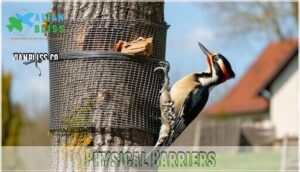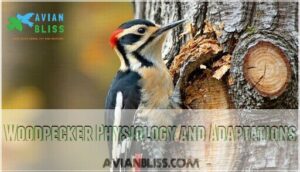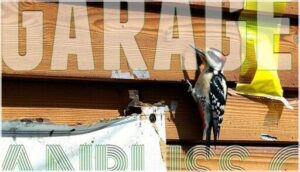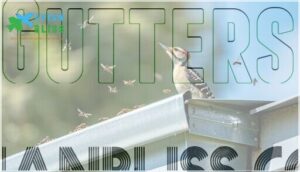This site is supported by our readers. We may earn a commission, at no cost to you, if you purchase through links.
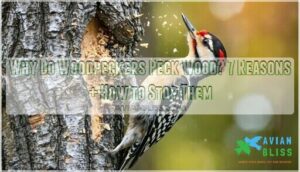 Woodpeckers peck wood for seven main reasons: hunting insects hiding beneath bark, communicating with other birds through rhythmic drumming, establishing territory, excavating nesting cavities, maintaining their sharp beaks, storing food, and sometimes just because your house happens to create the perfect acoustic chamber.
Woodpeckers peck wood for seven main reasons: hunting insects hiding beneath bark, communicating with other birds through rhythmic drumming, establishing territory, excavating nesting cavities, maintaining their sharp beaks, storing food, and sometimes just because your house happens to create the perfect acoustic chamber.
These specialized birds use their reinforced skulls and shock-absorbing anatomy to deliver up to 20 pecks per second without getting headaches.
Their zygodactyl feet (two toes forward, two back) and stiff tail feathers provide incredible grip on vertical surfaces.
Understanding these natural behaviors helps explain why they’re attracted to certain materials and locations around your property.
Table Of Contents
- Key Takeaways
- Woodpecker Behavior and Characteristics
- Preventing Woodpecker Damage
- Woodpecker Physiology and Adaptations
- Geographical Distribution and Migration
- Legal Protection and Professional Help
- Stop Woodpecker Damage on Different Surfaces
- Understanding Woodpecker Behavior and Concerns
- Frequently Asked Questions (FAQs)
- Conclusion
Key Takeaways
- You’ll face woodpecker damage because they’re hunting insects hiding in your wood – these birds drill through bark and siding to extract beetle larvae, carpenter ants, and wood-boring insects that indicate potential pest problems
- You can’t harm woodpeckers since they’re federally protected under the Migratory Bird Treaty Act – killing or injuring them carries heavy fines, so you’ll need to use humane deterrents like physical barriers, reflective tape, or noise devices
- You’re dealing with nature’s percussion section when woodpeckers drum on your property – they’re not just being destructive but are communicating with mates, marking territory, and creating nesting cavities using specialized anatomy that lets them peck up to 20 times per second
- You’ll get better results by addressing root causes rather than just the symptoms – remove food sources like insect infestations, install physical barriers over vulnerable areas, and use visual deterrents that exploit their natural wariness of unfamiliar stimuli
Woodpecker Behavior and Characteristics
You’ll notice woodpeckers hammering away at trees and wooden structures for surprisingly diverse reasons beyond just finding food.
Understanding their complex behaviors helps explain why these specialized birds seem so determined to make noise and create holes wherever they go, which is driven by their instinct to find food.
Pecking for Various Reasons
When woodpeckers target your home’s siding, they’re not just being destructive—they’re following natural instincts.
These persistent drummers aren’t vandals—they’re just following ancient survival instincts that made your home their target.
These birds peck wood for several critical survival reasons that drive their persistent behavior.
Here’s why woodpeckers can’t resist pecking:
- Food Search – Hunting beetle larvae and wood-boring insects hidden beneath bark
- Territorial Marking – Drumming sounds announce ownership to competing woodpeckers
- Mate Attraction – Rhythmic pecking creates courtship calls during breeding season
- Nest Creation – Excavating cavities in dead trees for safe nesting sites
Understanding woodpecker behavior helps explain their relentless insect hunting and territorial displays that seem to target your property.
Habitat and Nesting Habits
After understanding why woodpeckers peck, you’ll want to know where they’re setting up shop. These feathered architects don’t just randomly pick any old spot for their homes—they’re surprisingly picky about their real estate choices.
Nesting Sites become prime real estate when woodpeckers scout Dead Trees or decaying sections of healthy trees. The softened wood makes excavation easier, like choosing between digging through concrete versus sand. Both parents tag-team the construction project, taking turns to hollow out Tree Cavities that can extend over a foot deep.
These woodland engineers don’t just build for themselves—they’re inadvertently creating affordable housing for Forest Ecosystems. Once woodpeckers move out, their abandoned Tree Cavities become coveted nesting spots for bluebirds, wrens, and small owls who can’t excavate their own homes.
Here’s what makes their Nesting Habits so impressive:
- Strategic camouflage: They disguise entrances with lichen, bark, and moss
- Climate control: Cavities provide temperature regulation year-round
- Territorial markers: Woodpecker Adaptations include using these sites for communication
- Ecosystem support: Their work benefits entire Woodland Habitats through habitat creation
Feeding Habits
When dawn breaks, these feathered excavators launch into serious insect foraging.
Woodpeckers drill through bark targeting wood-boring larvae, carpenter ants, and beetle grubs hiding beneath.
Their chisel-like bills make perfect tools for nutrient extraction from tree crevices.
Beyond bug hunting, they practice food storage by caching seeds and enjoy sap feeding from maple trees during spring flows.
Preventing Woodpecker Damage
When woodpeckers target your home, you’ll want effective prevention methods that address their specific behaviors.
These birds respond well to strategic barriers, visual deterrents, and sound-based techniques that discourage pecking without harming them.
Physical Barriers
Physical barriers work like armor for your home against persistent woodpeckers.
Physical barriers create an impenetrable shield that stops determined woodpeckers cold.
Installing tree guards and netting systems creates an impenetrable shield that stops wood drilling before it starts.
To guarantee effective woodpecker deterrence, consider using methods that comply with legal woodpecker regulations.
- Hardware cloth: Secure ¼-inch mesh over vulnerable siding and eaves
- Bird netting: Cover large areas with ¾-inch mesh for complete protection
- Metal barriers: Install permanent visual barriers on chimneys and vents
Visual Deterrents
Several visual deterrents can trick woodpeckers into avoiding your property.
Shiny Reflectors like aluminum foil strips create moving light patterns that startle birds.
Bird Balloons with predator eyes mimic natural threats, while Predator Decals on windows simulate owls or hawks.
Flashing Lights and Colorful Streamers add motion-based deterrence.
These woodpecker deterrents work by exploiting birds’ natural wariness of unfamiliar visual stimuli, making your home less appealing without causing harm.
The use of shiny reflective materials can enhance the effectiveness of these deterrents.
The key to their success lies in the birds’ reaction to unfamiliar visual stimuli, and the fact that they make your home less appealing without causing harm.
Noise Scare Techniques
While drumming noises can drive you up the wall, strategic noise devices actually work against woodpeckers.
Motion-activated sonic repellents startle these persistent percussionists when they approach. Combine auditory deterrents with scare balloons and visual startlers for maximum impact.
Consistent noise patterns disrupt woodpecker drumming rhythms, making your property less appealing. These bird deterrents create an unpredictable environment that encourages territorial woodpeckers to relocate elsewhere.
Understanding the woodpecker control methods is essential to effectively stopping them from pecking wood, which is a key aspect of woodpecker control and using visual startlers to deter them.
Woodpecker Physiology and Adaptations
You’re probably wondering how woodpeckers can hammer away at trees all day without getting a massive headache or breaking their beaks.
These remarkable birds have evolved incredible physical adaptations that make them nature’s most efficient drilling machines.
Unique Toe Arrangement and Tail Feathers
You’ll notice woodpeckers grip trees like natural climbers thanks to their zygodactyl toe arrangement—two toes forward, two backward.
This toe grip creates rock-solid stability for vertical climbing on bark.
Their stiffened tail feathers work as a built-in kickstand, providing essential feather support and woodpecker balance during intense pecking sessions.
This perfect tree perch setup lets woodpecker species hammer away without tumbling down, showcasing their remarkable balance.
Special Jaw Muscles and Tendons
Woodpeckers possess remarkable jaw mechanics that work like nature’s ultimate shock absorber system.
Their specialized adductor mandibulae muscles attach extensively along the skull, creating a protective buffer during high-impact pecking. This intricate muscle-tendon arrangement absorbs forces exceeding 1000g while enabling up to 20 beats per second.
The woodpeckers’ ability to redirect energy is due to their unique energy conversion mechanisms that minimize brain injury risk.
- Jaw Structure: Top beak overhangs bottom beak, directing vibrations away from the brain
- Muscle Mechanics: Powerful jaw muscles cover and protect significant brain case portions during impact
- Tendon Function: Special muscle-tendon mechanism at jaw’s back functions as primary shock absorber
- Shock Absorption: System prevents whiplash injuries while maintaining precise pecking control throughout sustained drilling sessions
Flexible Skulls and Tongue Structure
Beyond those powerful jaw muscles, your skull structure acts like a natural shock absorber.
The skull’s spongy bone matrix compresses during impact, protecting your brain from 1,200G forces.
Your Y-shaped tongue extends deep into tree crevices, supported by nine thin bones, and specialized bristles filter wood chips, preventing debris inhalation while you extract insects with surgical precision.
Geographical Distribution and Migration
Woodpeckers inhabit nearly every continent except Antarctica, Australia, New Zealand, New Guinea, and Madagascar, with about 250 species thriving worldwide.
While most woodpeckers stay put year-round in their territories, some species like North American sapsuckers pack up and migrate seasonally to follow food sources.
Worldwide Distribution
You’ll find these incredible birds across six continents, showcasing remarkable Species Diversity and adaptability.
Their Worldwide Distribution spans diverse Forest Habitats from tropical rainforests to northern woodlands.
- Over 250 woodpecker species inhabit Global Patterns of forested regions worldwide
- They’re conspicuously absent from Antarctica, Australia, and isolated oceanic islands
- Dense populations thrive in South America and Southeast Asia’s rich forest ecology
This extensive Geographic Range reflects their evolutionary success across varied climates and ecosystems.
Migration Patterns
Migration patterns among North American woodpecker species showcase fascinating seasonal moves driven by food availability and breeding requirements.
Seven out of twenty species undertake regular migrations, while others remain year-round residents.
| Migration Type | Species Examples |
|---|---|
| Full Migrants | Yellow-bellied Sapsucker, Lewis’s Woodpecker |
| Partial Migrants | Northern Flicker (northern populations) |
| Resident Species | Hairy Woodpecker, Downy Woodpecker |
| Nomadic Movers | Red-headed Woodpecker (irregular patterns) |
Scientists use bird tracking technology to map migration routes and flyway patterns.
These habitat shifts reveal how woodpecker species adapt to changing seasons, with northern populations traveling from Canada to Mexico following tree trunk resources and insect availability.
Understanding bird migration patterns is essential for conservation efforts and protecting woodpecker habitats.
Legal Protection and Professional Help
Before you start DIY deterrent methods, you’ll need to know that woodpeckers are federally protected under the Migratory Bird Treaty Act, making it illegal to harm or kill them.
If damage becomes severe or persistent, contacting a licensed pest control professional can provide legal solutions and prevent costly repairs to your property.
Protection Under The Federal Migratory Bird Treaty Act
Before you can take action against woodpeckers, you’ll need to understand Federal Protection laws.
The Federal Migratory Bird Treaty Act shields these birds under strict Migratory Laws, making unauthorized removal illegal.
This Bird Conservation legislation guarantees Wildlife Preservation through Treaty Enforcement.
Environmental science research supports these protections, recognizing woodpeckers’ essential role in wildlife biology and ecosystem health.
Illegal to Kill Woodpeckers
Killing woodpeckers violates federal protection laws and carries serious consequences.
These birds enjoy thorough wildlife conservation rights under environmental ethics frameworks.
- Federal Protection – Woodpecker research supports bird conservation through the Migratory Bird Treaty Act
- Heavy Penalties – Violations result in substantial fines and potential criminal charges
- Species Conservation – Environmental conservation depends on protecting these ecosystem engineers
Instead, you’ll find success with humane deterrents like reflective tape, nest boxes, or protective barriers that respect woodpeckers’ natural behaviors.
Pest Control Estimates and Professional Services
Professional pest control services offer thorough woodpecker management solutions when DIY methods fall short.
You’ll find that damage repair costs typically range from $450-$650 for standard treatments, while specialized services can reach $2,000 depending on your property’s complexity.
Leading companies like Terminix provide multi-sensory deterrent systems combining audio, visual, and chemical approaches.
These professionals assess structural damage, identify insect control needs targeting carpenter ants and wood-boring larvae that attract woodpeckers, and implement prevention services.
They’ll handle tree damage evaluation and wood treatment applications while ensuring compliance with federal protection laws.
The pest control industry’s $24.9 billion market includes specialized woodpecker infestation removal techniques.
Professional services emphasize early intervention – it’s much easier preventing established drumming patterns than breaking them.
You’ll receive thorough damage repair, ongoing monitoring, and food source management.
This approach tackles root causes like termite colonies while installing effective deterrent systems that respect wildlife protection requirements.
Stop Woodpecker Damage on Different Surfaces
Different surfaces around your home present unique challenges when dealing with persistent woodpecker activity.
Each area requires targeted strategies based on the specific reasons these birds choose to peck on garages, gutters, and windows.
Garage
Your garage’s wooden surfaces attract woodpeckers hunting for insects like carpenter ants and termites.
Canvas tarps or sheet metal coverings provide effective garage protection against persistent pecking. Visual deterrents including reflective tape, windsocks, and predator decoys can discourage these determined birds.
Address any existing wood damage promptly through siding repair to prevent further attraction. Professional bird control services offer thorough solutions for severe garage damage situations.
Understanding their behavior, drumming serves communication, mating, and territory defense is crucial for effective management.
Gutters
Woodpeckers target gutters for their amplified drumming sounds and insect-hunting opportunities. Metal gutter materials create perfect resonance chambers for territorial communication, while accumulated debris attracts wood-boring insects.
- Install gutter guards – Mesh covers prevent access while maintaining water flow
- Apply reflective tape – Shiny surfaces create visual confusion and deter approach
- Use wind chimes – Consistent gutter sounds mask drumming effectiveness
- Seal entry points – Repair existing gutter damage immediately to prevent return visits
- Consider gutter alternatives – Copper materials resist pecking behavior better than aluminum
Professional gutter deterrents protect your drainage system from costly repairs. Consider specialized woodpecker products for enhanced protection.
Windows
Window drumming and reflection aggression plague homeowners when woodpeckers mistake glass surfaces for rival territory markers.
Install visual deterrents like reflective tape or decoy windows to redirect their pecking behavior.
Moving feeders away from windows reduces food search attractions.
Consider window materials that minimize reflections, preventing damage while respecting these territorial birds’ natural instincts, and utilize visual deterrents to address the issue of window drumming.
Understanding Woodpecker Behavior and Concerns
Understanding woodpecker behavior helps you identify why these birds target your property and determine if their activity poses real concerns.
Once you know whether they’re hunting insects, establishing territory, or building nests, you can choose the most effective deterrent methods.
Reasons for Pecking Wood
Behind every rapid-fire drumbeat lies purpose.
Woodpeckers engage in pecking wood for five primary reasons: food search to extract insects from bark crevices, territory marking through distinctive drumming patterns, mate attraction via rhythmic acoustic displays, nest creation by drilling protective cavities, and insect extraction from deep wood layers.
This tree drilling behavior serves essential survival functions, from securing protein-rich larvae to establishing breeding territories.
Understanding these woodpecking reasons helps explain why these persistent percussionists target specific surfaces for their territorial marking campaigns.
Woodpeckers often exhibit behaviors related to woodpecker attraction that can be mitigated with the right strategies to address woodpecker attraction and reduce territorial marking.
Evaluating Potential Concerns
Understanding these pecking patterns helps you assess real threats to your property.
Woodpeckers targeting structural wood often indicate insect infestation beneath surfaces, requiring immediate pest management attention.
Consider these damage assessment priorities:
- Structural integrity – Check siding, trim, and roofing for extensive tree drilling that compromises building materials
- Moisture infiltration – Examine cavities for water damage that attracts fungi and secondary pest problems
- Activity timing – Monitor seasonal pecking wood behaviors to implement targeted woodpecker control strategies
Frequently Asked Questions (FAQs)
Do woodpeckers ever damage their beaks?
No, you’ll rarely see damaged woodpecker beaks.
These birds evolved incredible adaptations—shock-absorbing muscles, reinforced skull structure, and nearly unbreakable beaks that withstand tremendous force without breaking or causing pain during their relentless pecking sessions, which is a result of their relentless pecking.
Can woodpeckers peck through metal surfaces?
Woodpeckers can’t actually peck through solid metal, but they’ll drum on metal surfaces like gutters and chimney caps to amplify their territorial calls and attract mates.
What time of day do woodpeckers peck most?
Peak activity occurs between 5-7 AM when 80% of foraging happens.
You’ll hear them most during dawn hours when insects are active and competition is low.
Early morning drumming establishes territory before other birds wake up, which is a key part of their daily behavior, especially during dawn hours.
Do baby woodpeckers know how to peck naturally?
Baby woodpeckers don’t instinctively know how to peck effectively.
They’re born with basic reflexes but must learn proper technique through practice and parental guidance.
Young birds develop their signature drilling skills gradually over weeks.
How fast do woodpeckers peck per second?
You’ll witness these feathered percussion masters drumming at 10-20 pecks per second during regular foraging.
When they’re really showing off with territorial drumming, they’ll ramp up to an impressive 20 beats per second – that’s faster than your eye can follow!
Conclusion
Understanding why woodpeckers peck wood isn’t rocket science, but it’s nature’s percussion section at work.
These feathered contractors excavate for insects, establish territories, create nesting sites, communicate through drumming, maintain their beaks, and store food.
When they target your property, use physical barriers, visual deterrents, or noise techniques.
Remember, they’re federally protected, so focus on humane prevention methods that work with their natural behaviors.
- https://woodbeaver.net/why-does-a-woodpecker-peck-wood-exploring-the-fascinating-science-behind-this-habit-plus-tips-for-protecting-your-trees/
- https://toolsvoice.com/why-do-woodpeckers-peck-wood/
- https://www.forestwildlife.org/why-does-a-woodpecker-peck-wood/
- https://www.researchgate.net/publication/317248588_A_study_of_woodpecker%27s_pecking_process_and_the_impact_response_of_its_brain
- https://www.adfg.alaska.gov/index.cfm?adfg=wildlifenews.view_article&articles_id=53

